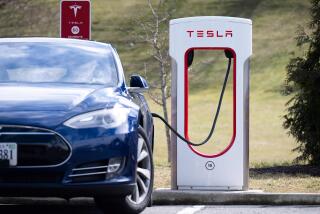THE GOODS : That New Car May Not Be as Cool as You Think
- Share via
The dog days of summer are always worst when you have to get in your car after it has been parked for a few hours in the sun. The interior temperature can approach 150 degrees.
Auto makers have substantially improved air-conditioning technology over the years, but consumers are still blundering into unknown territory when they assume that the air-conditioning system on a new car will be adequate.
No manufacturer puts a rating on its air conditioners similar to those carried on residential cooling systems. In some cases, the systems are adequate; in other cases, they are underpowered.
The ability to keep a car cool depends on many factors, including the engine speed, the outside temperature and even the vehicle’s color. When idling in traffic, for example, the engine does not supply much power to the compressor unit and only small amounts of Freon circulate through the system. In addition, little air reaches the condenser unit under the hood when the car idles.
The trend in auto sales toward minivans, sport utility vehicles and station wagons is making cooling off even harder, because the big vehicles have an enormous amount of window area. When parked in the sun, these vehicles become like solar ovens. Steering wheels can get so hot they are sometimes dangerous to touch.
It would seem that a big vehicle would have a big air-conditioning system, but that is hardly ever the case. Auto makers often use the same systems in big vehicles as they do in smaller vehicles, said Frank Allison, chief of the International Mobile Air Conditioning Assn., a trade group.
For example, models that come in both sedans and station wagons typically have the same capacity air conditioner, despite the fact that the station wagons have 50% more interior volume, Allison said.
The problem is particularly acute in minivans and sport utility vehicles, Allison said, because it is difficult to get adequate air circulation throughout the vehicle.
Of course, this is not what consumers expect. Ninety-four percent of U.S.-made vehicles sold in 1994 were equipped with air conditioning. Just 29% of 1973 Chevy Vegas had air, but who would want one of those cars today?
One big improvement would be the use of cooling fans that purged hot air inside a parked car. Mazda introduced such a system on some of its models, using solar cells to power the fans, but other manufacturers have not followed.
If your air conditioner isn’t keeping your minivan cool enough, you have some options. An obvious one is to tint the rear windows. Another, less attractive, option is to buy a small fan that operates off the 12-volt electrical system, which can help move air around the vehicle. The air conditioner will be more efficient if it can circulate the hot air through the evaporator core under the dash.
* Vartabedian cannot answer mail personally but will attempt to respond in this column to automotive questions of general interest. Do not telephone. Write to Your Wheels, 1875 I St. N.W. #1100, Washington, D.C. 20006.







